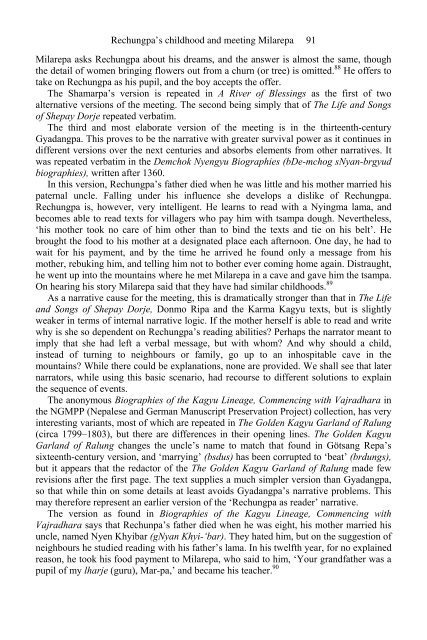The Biographies of Rechungpa: The Evolution of a Tibetan ...
The Biographies of Rechungpa: The Evolution of a Tibetan ...
The Biographies of Rechungpa: The Evolution of a Tibetan ...
You also want an ePaper? Increase the reach of your titles
YUMPU automatically turns print PDFs into web optimized ePapers that Google loves.
<strong>Rechungpa</strong>’s childhood and meeting Milarepa 91<br />
Milarepa asks <strong>Rechungpa</strong> about his dreams, and the answer is almost the same, though<br />
the detail <strong>of</strong> women bringing flowers out from a churn (or tree) is omitted. 88 He <strong>of</strong>fers to<br />
take on <strong>Rechungpa</strong> as his pupil, and the boy accepts the <strong>of</strong>fer.<br />
<strong>The</strong> Shamarpa’s version is repeated in A River <strong>of</strong> Blessings as the first <strong>of</strong> two<br />
alternative versions <strong>of</strong> the meeting. <strong>The</strong> second being simply that <strong>of</strong> <strong>The</strong> Life and Songs<br />
<strong>of</strong> Shepay Dorje repeated verbatim.<br />
<strong>The</strong> third and most elaborate version <strong>of</strong> the meeting is in the thirteenth-century<br />
Gyadangpa. This proves to be the narrative with greater survival power as it continues in<br />
different versions over the next centuries and absorbs elements from other narratives. It<br />
was repeated verbatim in the Demchok Nyengyu <strong>Biographies</strong> (bDe-mchog sNyan-brgyud<br />
biographies), written after 1360.<br />
In this version, <strong>Rechungpa</strong>’s father died when he was little and his mother married his<br />
paternal uncle. Falling under his influence she develops a dislike <strong>of</strong> <strong>Rechungpa</strong>.<br />
<strong>Rechungpa</strong> is, however, very intelligent. He learns to read with a Nyingma lama, and<br />
becomes able to read texts for villagers who pay him with tsampa dough. Nevertheless,<br />
‘his mother took no care <strong>of</strong> him other than to bind the texts and tie on his belt’. He<br />
brought the food to his mother at a designated place each afternoon. One day, he had to<br />
wait for his payment, and by the time he arrived he found only a message from his<br />
mother, rebuking him, and telling him not to bother ever coming home again. Distraught,<br />
he went up into the mountains where he met Milarepa in a cave and gave him the tsampa.<br />
On hearing his story Milarepa said that they have had similar childhoods. 89<br />
As a narrative cause for the meeting, this is dramatically stronger than that in <strong>The</strong> Life<br />
and Songs <strong>of</strong> Shepay Dorje, Donmo Ripa and the Karma Kagyu texts, but is slightly<br />
weaker in terms <strong>of</strong> internal narrative logic. If the mother herself is able to read and write<br />
why is she so dependent on <strong>Rechungpa</strong>’s reading abilities? Perhaps the narrator meant to<br />
imply that she had left a verbal message, but with whom? And why should a child,<br />
instead <strong>of</strong> turning to neighbours or family, go up to an inhospitable cave in the<br />
mountains? While there could be explanations, none are provided. We shall see that later<br />
narrators, while using this basic scenario, had recourse to different solutions to explain<br />
the sequence <strong>of</strong> events.<br />
<strong>The</strong> anonymous <strong>Biographies</strong> <strong>of</strong> the Kagyu Lineage, Commencing with Vajradhara in<br />
the NGMPP (Nepalese and German Manuscript Preservation Project) collection, has very<br />
interesting variants, most <strong>of</strong> which are repeated in <strong>The</strong> Golden Kagyu Garland <strong>of</strong> Ralung<br />
(circa 1799–1803), but there are differences in their opening lines. <strong>The</strong> Golden Kagyu<br />
Garland <strong>of</strong> Ralung changes the uncle’s name to match that found in Götsang Repa’s<br />
sixteenth-century version, and ‘marrying’ (bsdus) has been corrupted to ‘beat’ (brdungs),<br />
but it appears that the redactor <strong>of</strong> the <strong>The</strong> Golden Kagyu Garland <strong>of</strong> Ralung made few<br />
revisions after the first page. <strong>The</strong> text supplies a much simpler version than Gyadangpa,<br />
so that while thin on some details at least avoids Gyadangpa’s narrative problems. This<br />
may therefore represent an earlier version <strong>of</strong> the ‘<strong>Rechungpa</strong> as reader’ narrative.<br />
<strong>The</strong> version as found in <strong>Biographies</strong> <strong>of</strong> the Kagyu Lineage, Commencing with<br />
Vajradhara says that Rechunpa’s father died when he was eight, his mother married his<br />
uncle, named Nyen Khyibar (gNyan Khyi-‘bar). <strong>The</strong>y hated him, but on the suggestion <strong>of</strong><br />
neighbours he studied reading with his father’s lama. In his twelfth year, for no explained<br />
reason, he took his food payment to Milarepa, who said to him, ‘Your grandfather was a<br />
pupil <strong>of</strong> my lharje (guru), Mar-pa,’ and became his teacher. 90











